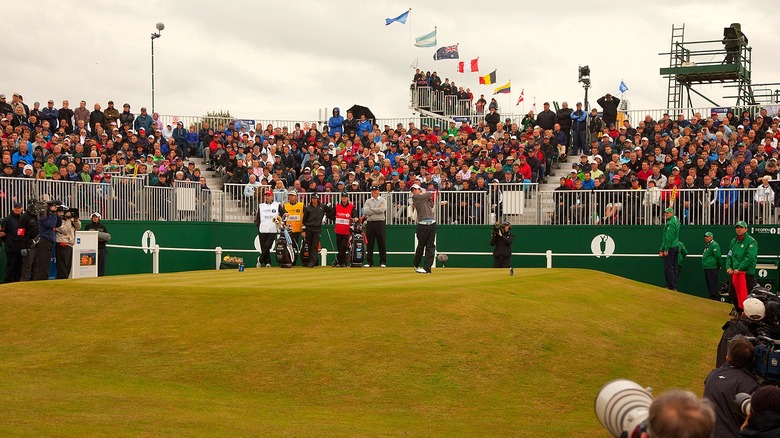This Is How Much Money PGA Golfers Really Make In A Tournament
The life of a professional golfer can seem glamorous, not to mention intensely satisfying. Anyone who enjoys getting out for a round with their foursome on a weekend morning likely looks on with at least a bit of envy at their favorite PGA Tour pro. This feeling is often aimed both at the courses these players get to experience and the seemingly miraculous ball flights they can produce at will.
PGA Tour professionals play with the best gear around and look to lead an immensely relaxing life strolling around impeccably manicured courses every weekend. But there's another side to the life of a professional golfer that revolves intimately around solid budgeting practices. Yes, the most famous pros on the Tour take home gigantic sums of money. Yet, they spend oodles of time on the road, and have to pay for their travel arrangements and other related expenses on their own.
The financials of becoming and remaining a PGA player are complicated, to say the least. Each tournament is unique in its prize money, with The Players Championship offering the largest purse of any tournament ($25 million in total winnings and $4.5 million for the winner in the 2024 season). All told, players competing in PGA events during the 2024 season will have the opportunity to win their share of more than $400 million in total prize money throughout the year. But individual golfers will carve their own path when it comes to earnings on a weekly basis.
Minimum 'salary' for new players
The base pay program, new in the 2022-23 season, began guaranteeing rookie and Korn Ferry Tour veterans entering the PGA circuit a minimum of $500,000 — against earnings. (With all that money on the line, there's even the need to introduce legal and healthy tax avoidance practices into a golfer's life.) PGA Tour players who win less than this figure get to keep the difference, and those who rake in more only begin to collect on winnings once they've passed the half-a-million figure. In this way, it's like an advance, but one that players are guaranteed, regardless of their performance. In the first season of the base pay rollout, about 200 players were given the guaranteed cash advance.
Also, the PGA has provided a $5,000 reimbursement of sorts for expenses for players with lower rankings when they miss a tournament cut. This provides a major lifeline for some PGA competitors, considering all the rest of the financial math that goes into travel, gear, accommodation, and more for every single tournament. The reality is that many players on the PGA Tour find themselves firmly in the "middle class," even as they lead a fast-paced, jet-setting lifestyle while playing a game to earn their keep!
Earnings are weighed against expenses
The typical PGA Tour player will play in 20 to 30 tournaments every year. This means dozens of weekends playing multiple rounds of competitive and highly demanding golf — unlike the relaxing afternoon out that us mortals enjoy every week or two. The typical tournament schedule tees off on a Thursday, but PGA players often arrive in a tournament location on the Monday — sometimes after finishing up their previous competitive efforts the evening before. It's typical for a professional golfer to spend $5,000 or more just to show up and play in a tournament, making each event a must-earn atmosphere for everyone entering the fray. With a full schedule of events on their calendar, a PGA pro will easily spend $100,000 or more in order to actually "work" at their day job.
Golfers on the PGA Tour are able to earn money through various channels beyond tournaments, including sponsorship deals or even (in the recent past) by defecting to the LIV Golf circuit. In terms of sponsorship money, Rory McIlroy is said to be the highest-paid golfer in pure endorsement cash. It's reported that McIlroy, a four-time major champion, rakes in $40 million every year from brand partnerships alone. But this volume of cash infusion doesn't hold true for the vast majority of players, especially those on the margins of the PGA's rarified Tour Cards. Those in Q School or other forms of "minor league" play earn but a fraction of what Tour professionals take home, both in earnings from play and in sponsorship deals.
Average winnings reach above $1.5 million
In the modern game, the highest-earning golfers on the PGA Tour can expect to take home gigantic purses on Sunday. Current No. 1 in the world Scottie Scheffler, for example, earned a truly staggering $21,014,342 in the 2022-23 season, making him the highest single-season earner ever. His winnings cast a long shadow over the Tour average, which was $1.6 million for the 2021-22 season. Moreover, 218 players on the Tour took home more than $100,000 while little over half that number pocketed over $1 million in earnings (126 Tour players).
This doesn't take into account the most important expense that Tour pros have to manage, however. Caddies are instrumental to a player's success on the course. They are paid by the players themselves, earning roughly $1,500 to $3,000 per week and share in a percentage of the player's winnings (5% to 10%, depending on the finish). Players will often tip their caddies, as well, adding a bit more to the overall cost of their course- and shot-management partner. At the end of the day, however, earnings can be incredibly lucrative for the best golfers in the world — allowing them to travel constantly and competitively play a game millions of people love (and sometimes hate) in front of live crowds and countless spectators tuning in to witness the spectacle.



